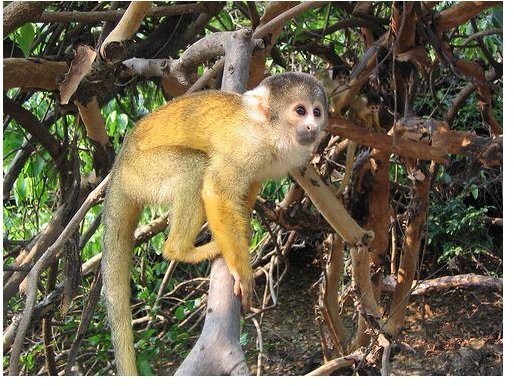Adaptations of Squirrel Monkeys: What are They and How do They Help?
How Squirrel Monkeys Adapt to their Environment
Squirrel monkeys are primates that are about the same size as squirrels, with the average adult being 10-14 inches. What distinguishes them from other monkeys is their slender body and prominent white markings around the eyes, ears, nose, and throat. Their tails are usually longer than the body and are bi-colored with a black tip.
These monkeys prefer to live in rainforests, and although they are found in many parts of the world like Central and South America, Bolivia, Brazil, Colombia, Ecuador, French Guiana, Guyana, Peru, Suriname, Paraguay and Venezuela, their habits do not differ with different locations. This is because they are arboreal - in other words, they prefer to live in trees in the middle or upper canopy of the rainforest. They like any vegetation that provides them with ample cover from birds of prey, and have been found in the rainforests, mangroves, savannahs, and marshlands. They come to the ground only on rare occasions.
Here are the different adaptations of the squirrel monkeys that have helped them survive.
Teeth – The cheek teeth have large cusps to help them eat insects. Males usually have larger canine teeth than females.
Movement – The monkeys move predominantly by leaping, and have special adapted thighs that are smaller than their lower legs. This gives them greater jumping force and the ability to travel longer distances.
Tail – The tail of squirrel monkeys, unlike other monkeys, is not prehensile, for instance, capable of grasping. It is only a feature that is present in infants, but in adults the tail is more importantly used for balancing on the branches.
Fingers – Because of their preference for fruits that need to be plucked, and insects hidden in the crevices of trees, squirrel monkeys have extremely dexterous fingers. The thumb is short, but well developed, and the fingers are quite useful for clutching trees or finding hidden fruits and insects.
Secretion – The monkeys generally spread urine on their hands and feet. This is done to mark their territory and alert other monkeys. A musky glandular secretion from their fur is present all over the body, especially the tail. This helps in marking their territory, and leaving a trail for other monkeys of the group to follow. The major help from this secretion is it wards off predators from their territory, as they cannot stand the smell.
Food – Squirrel monkeys are frugivorous and insectivorous animals. They prefer to eat berries, plucking them from the branches, and rely on these fruits for their water requirements. They occasionally drink water from the holes in trees and puddles. When fruits are scarce, they drink nectar. They rarely go after a moving insect, and prefer those present on the plant surface, especially caterpillar and grasshoppers. Among small vertebrates, squirrel monkeys often search for bats in the large trees, and also consume bird eggs and small birds. Their food habits, thus, are adaptations of squirrel monkeys well suited to their life on trees.
Social Behavior – Because of their small size, squirrel monkeys are often under threat from raptors, snakes, and felids. To protect themselves, they prefer to live in large groups with adult females and their young ones forming the core of the group. One distinct adaptation seen in these monkeys in Peru is the way they form mixed groups with other monkey species like the Cebus. They live peacefully with each other, and because of the extensive alarm calling system of the C_ebus_ monkeys, the group is given predator alert in advance.
The squirrel monkeys thus survive on tree tops through their omnivorous food choices and special body adaptations.
Reference
https://www.zooschool.ecsd.net/squirrel%20monkey.htm
https://www.arkive.org/red-backed-squirrel-monkey/saimiri-oerstedii/info.html
https://pin.primate.wisc.edu/factsheets/entry/squirrel_monkey
Image Credit
Photo by Phillie Casablanca via cc/Flickr
